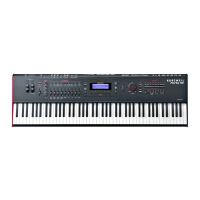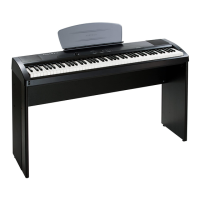Program Edit Mode
Editing VAST Programs With KVA Oscillators
3-77
frequency to move up 10800 cents from its initial value, a velocity of 0 will have no eect on
the cut o frequency, and values in between will increase the cut o frequency by a scaling
between 0 and 10800 cents. Overall, this will cause higher played velocities to increase the
cut o frequency, making the oscillator sound brighter, and lower velocities to lower the cut
o frequency, making the oscillator sound duller. is method can be used to control any
DSP function that is loaded into an algorithm. See The DSP Control (DSP CTL) Page on
page 3-53 for other control parameters available on the DSP CTL page.
Alternatively, you could assign cut o frequency to be controlled by any continuous
controller, such as the Mod Wheel. Start again with the unedited Program 2046 Editor
Template. Follow the same steps as above, but instead of changing any parameters on the
DSP CTL page, press the DSP MOD soft button to reach the DSP Modulation page. On
the left side of the screen, choose the parameter for LP Frq, and then press the right cursor
button to reach the LP Frq sub page. On this sub page, you can assign any continuous
controller to control the cut o frequency of the LOPASS function (or the main parameter
for any function loaded in the current algorithm). Select the Source 1 parameter, hold the
ENTER button and move the Mod Wheel to quickly select MWheel (the Mod Wheel)
as your control source. Next, press the cursor down button to select the Depth parameter,
then use the alpha wheel or alpha numeric pad to turn it all the way up to 10800ct. Now
the Mod Wheel will aect the LP Frq parameter. Moving the Mod Wheel all the way up
(a value of 127) will cause the lter’s cut o frequency to move up 10800 cents from its
initial value, moving the Mod Wheel all the way down (a value of 0) will have no eect on
the cut o frequency, and values in between will increase the cut o frequency by a scaling
between 0 and 10800 cents. Now you have the same control over cut o frequency as you
did in the previous example, but now it is controlled by the Mod Wheel. Overall, moving
the Mod Wheel up will increase the cut o frequency, making the oscillator sound brighter,
and moving the Mod Wheel down will lower the cut o frequency, making the oscillator
sound duller. is is useful to control a classic “lter sweep” sound. e above method can be
used to control any DSP function that is loaded into an algorithm, and you can choose any
continuous controller as a control source.
Oscillator Specic Control And Modulation Parameters:
Several KVA oscillators also have their own modulation parameters that must be accessed
to control the oscillator’s intended function. Below is a list of these oscillators and their
distinctive parameters, grouped by block size. ough the following parameters could be
left at one setting, utilizing one of the DSP CTL or DSP MOD techniques described in the
above examples will expose a wider range of expression from each oscillator.
1 Block:
LPNOIZ
A noise generator combined with a low pass lter. Use the Noiz Frq parameter to control the
cut o frequency of the lter.

